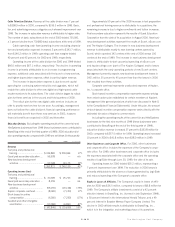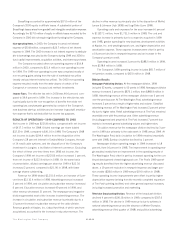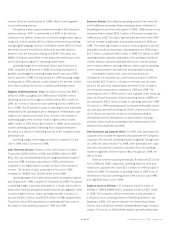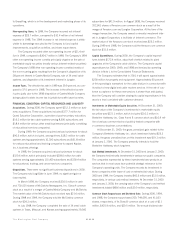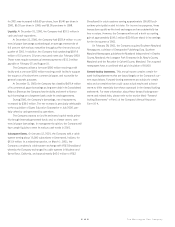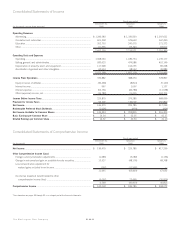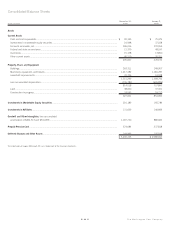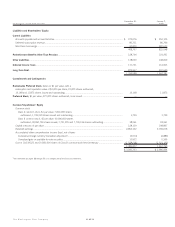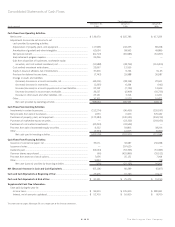Washington Post 2000 Annual Report Download - page 13
Download and view the complete annual report
Please find page 13 of the 2000 Washington Post annual report below. You can navigate through the pages in the report by either clicking on the pages listed below, or by using the keyword search tool below to find specific information within the annual report.
Notes to Consolidated Financial Statements
IA ISUMMARY OF SIGNIFICANT ACCOUNTING POLICIES
The Washington Post Company (the “Company”) is a diversified media
organization whose principal operations consist of newspaper publish-
ing (primarily The Washington Post newspaper), television broadcast-
ing (through the ownership and operation of six network-affiliated
television stations), the ownership and operation of cable television
systems, and magazine publishing (primarily Newsweek magazine).
Through its subsidiary Kaplan, Inc., the Company provides educa-
tional services for individuals, schools and businesses. The Company
also owns and operates a number of media Web sites for the primary
purpose of developing the Company’s newspaper and magazine
publishing businesses on the World Wide Web.
Fiscal Year. The Company reports on a 52-53 week fiscal year ending
on the Sunday nearest December 31. The fiscal years 2000 and 1999,
which ended on December 31, 2000 and January 2, 2000, respec-
tively, both included 52 weeks, while 1998, which ended on January
3, 1999, included 53 weeks. With the exception of the newspaper
publishing operations, subsidiaries of the Company report on a calen-
dar-year basis.
Principles of Consolidation. The accompanying financial statements
include the accounts of the Company and its subsidiaries; significant
intercompany transactions have been eliminated.
Presentation. Certain amounts in previously issued financial state-
ments have been reclassified to conform to the 2000 presentation.
Use of Estimates. The preparation of financial statements in conformity
with generally accepted accounting principles requires management to
make estimates and assumptions that affect the amounts reported in the
financial statements. Actual results could differ from those estimates.
Cash Equivalents. Short-term investments with original maturities of
90 days or less are considered cash equivalents.
Investments in Marketable Equity Securities. The Company’s invest-
ments in marketable equity securities are classified as available-for-
sale and therefore are recorded at fair value in the Consolidated
Balance Sheets, with the change in fair value during the period
excluded from earnings and recorded net of tax as a separate compo-
nent of comprehensive income.
Inventories. Inventories are valued at the lower of cost or market. Cost
of newsprint is determined by the first-in, first-out method, and cost
of magazine paper is determined by the specific-cost method.
Property, Plant, and Equipment. Property, plant, and equipment is
recorded at cost and includes interest capitalized in connection with
major long-term construction projects. Replacements and major
improvements are capitalized; maintenance and repairs are charged
to operations as incurred.
Depreciation is calculated using the straight-line method over the
estimated useful lives of the property, plant, and equipment: 3 to 20
years for machinery and equipment, and 20 to 50 years for buildings.
The costs of leasehold improvements are amortized over the lesser
of the useful lives or the terms of the respective leases.
Investments in Affiliates. The Company uses the equity method of
accounting for its investments in and earnings or losses of affiliates
for which it does not control but does exert significant influence.
Cost Method Investments. The Company uses the cost method of
accounting for its minority investments in non-public companies
where it does not have significant influence over the operations and
management of the investee. Investments are recorded at the lower
of cost or fair value as estimated by management.
Goodwill and Other Intangibles. Goodwill and other intangibles repre-
sent the unamortized excess of the cost of acquiring subsidiary
companies over the fair values of such companies’ net tangible assets
at the dates of acquisition. Goodwill and other intangibles are being
amortized by use of the straight-line method over periods ranging from
15 to 40 years (with the majority being amortized over 15 to 25 years).
Long-lived Assets. The recoverability of long-lived assets, including
goodwill and other intangibles, is assessed whenever adverse events
and changes in circumstances indicate that previously anticipated
undiscounted cash flows warrant assessment.
Program Rights. The broadcast subsidiaries are parties to agreements that
entitle them to show syndicated and other programs on television. The
cost of such program rights is recorded when the programs are available
for broadcasting, and such costs are charged to operations as the
programming is aired.
Revenue Recognition. Revenue from media advertising is recognized,
net of agency commissions, when the underlying advertisement is
published or broadcast. Revenues from newspaper and magazine sub-
scriptions are recognized upon delivery. Revenues from newspaper and
magazine retail sales are recognized upon delivery with adequate provi-
sion made for anticipated sales returns. Cable subscriber revenue is
recognized monthly as earned. Education revenue is recognized ratably
over the period during which educational services are delivered.
The Company bases its estimates for sales returns on historical
experience and has not experienced significant fluctuations between
estimated and actual return activity. Amounts received from customers
in advance of revenue recognition are deferred as liabilities. Deferred
revenue to be earned after one year is included in “Other Liabilities”
in the Consolidated Balance Sheets.
Postretirement Benefits Other Than Pensions. The Company provides
certain healthcare and life insurance benefits for retired employees.
38 The Washington Post Company


